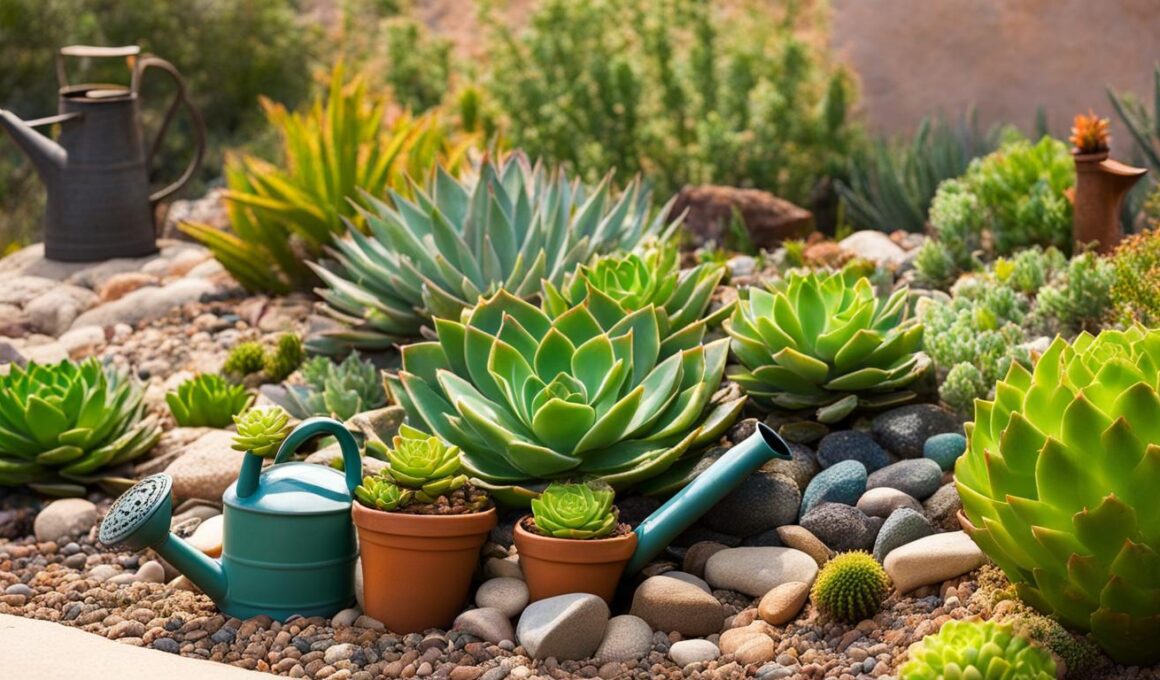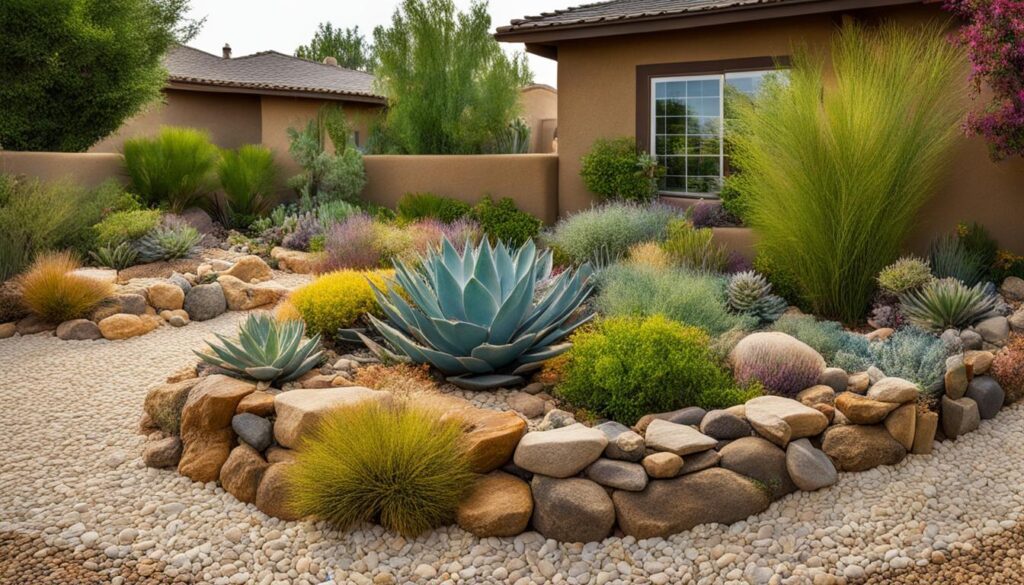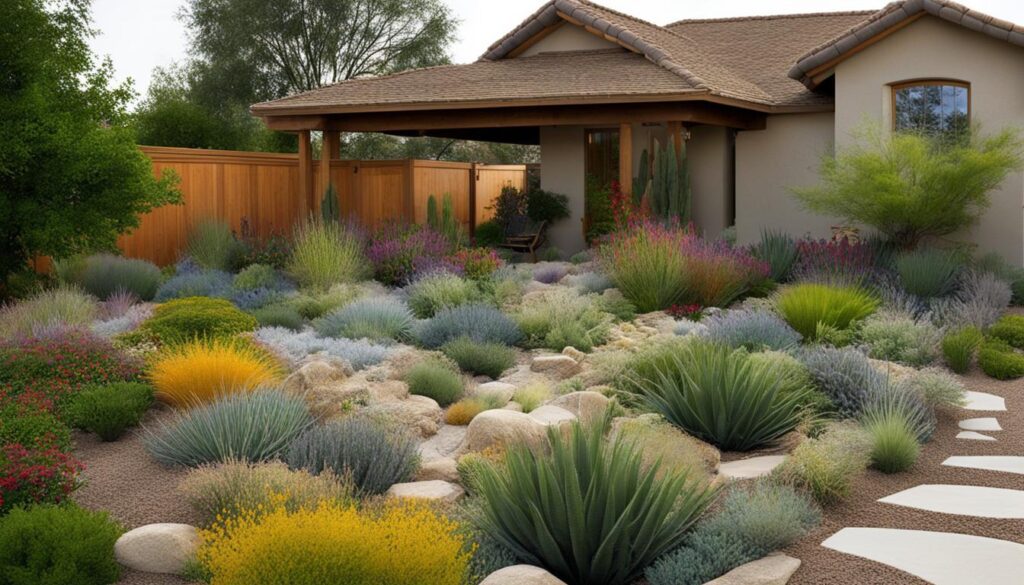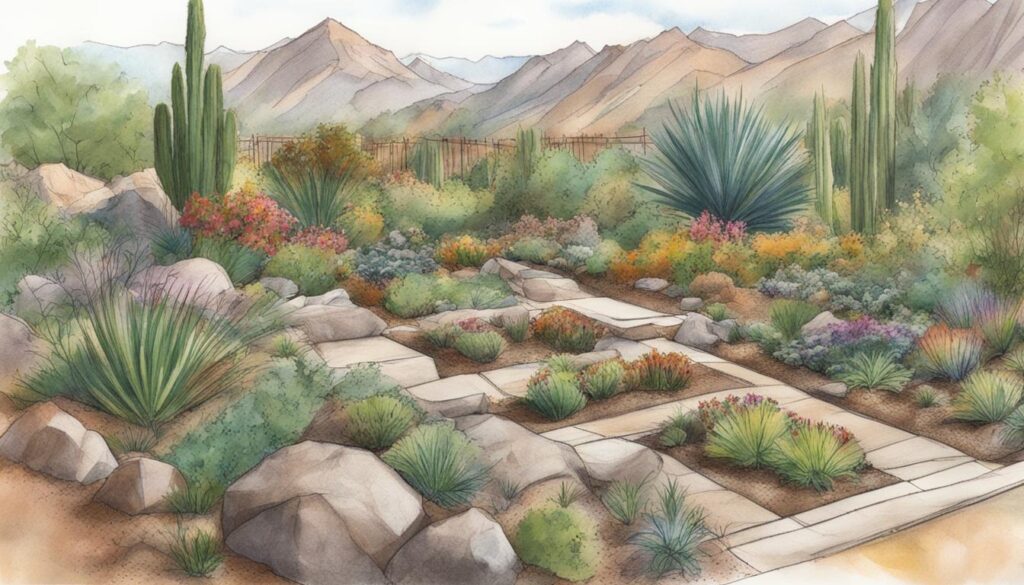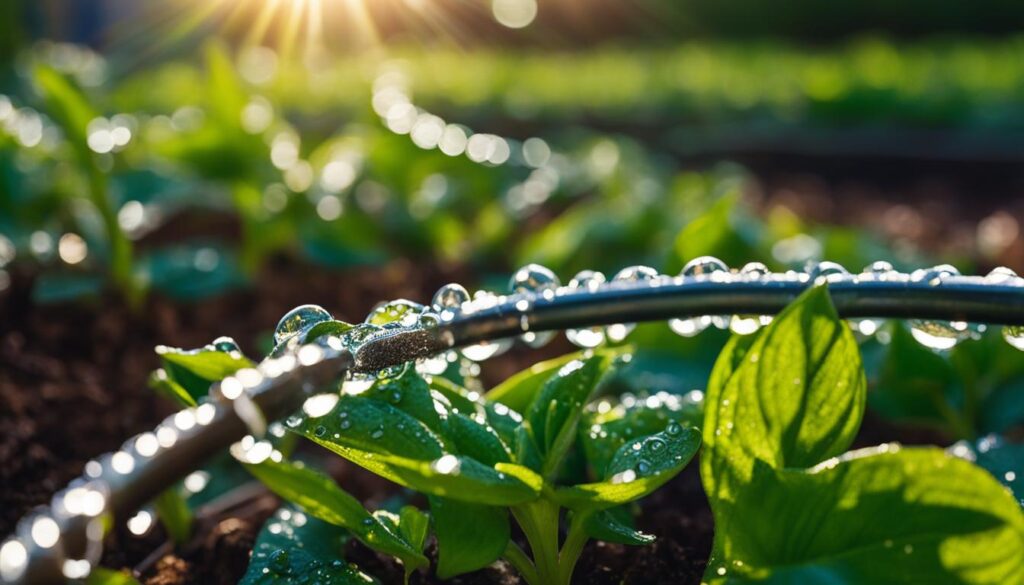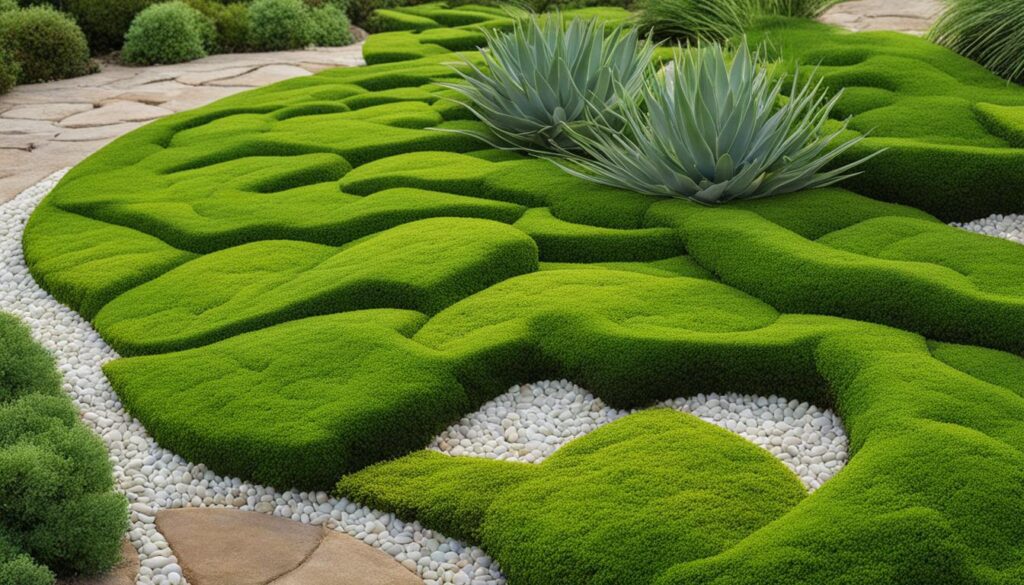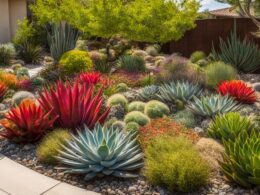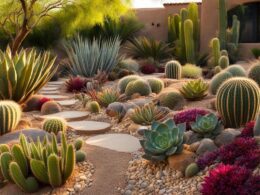Welcome to our comprehensive guide on DIY xeriscaping for home gardens. In this article, we will explore how you can create a sustainable and water-wise landscape that not only enhances the beauty of your property but also conserves water and reduces maintenance efforts. Xeriscaping has become increasingly popular as an eco-friendly solution for landscaping, especially in areas facing water scarcity. Let’s dive in and discover how you can transform your garden into a thriving and sustainable oasis.
Key Takeaways:
- DIY xeriscaping is a water-wise landscaping technique that reduces irrigation needs and maximizes the use of natural precipitation.
- By implementing xeriscaping in your home garden, you can save water, cut down on costs, and enhance the curb appeal of your property.
- Xeriscaping involves planning and design, improving soil, efficient irrigation, grouping plants based on water needs, using mulch, considering turf alternatives, and proper maintenance.
- By following the principles of xeriscaping, homeowners can create a beautiful and sustainable garden that conserves water and benefits the environment.
- Start your DIY xeriscaping journey today and enjoy the long-term benefits of water conservation and sustainable landscaping.
What is Xeriscaping?
Xeriscaping is a landscaping technique that embraces water-wise principles to reduce irrigation needs and maximize the use of natural precipitation. Originally coined by the Denver Water Board, xeriscaping has gained popularity as an eco-friendly and sustainable solution for home gardens. By implementing xeriscaping techniques, you can create a beautiful and thriving garden that requires less water and is better suited to your local climate.
Xeriscaping focuses on designing and maintaining landscapes that are adapted to the local climate and minimize water usage. This means selecting plants that are drought-tolerant, grouping them based on their water needs, and optimizing irrigation techniques to minimize water loss. By adopting xeriscaping in your home garden, you can contribute to water conservation efforts while still enjoying a visually appealing and sustainable outdoor space.
The Benefits of Xeriscaping
- Xeriscaping reduces water consumption: By choosing plants that require less water and implementing efficient irrigation methods, xeriscaping can significantly reduce your overall water usage.
- Xeriscaping saves money: With reduced water consumption, you’ll see a noticeable decrease in your water bills, saving you money in the long run.
- Xeriscaping is low-maintenance: Once established, xeriscaped gardens require less maintenance compared to traditional landscapes. You’ll spend less time watering, mowing, and maintaining your garden, allowing you to enjoy your outdoor space more.
- Xeriscaping enhances curb appeal: Xeriscaped gardens can be just as beautiful and visually appealing as traditional landscapes. With careful planning and design, you can create an eye-catching garden that boosts the curb appeal of your property.
- Xeriscaping promotes environmental sustainability: By reducing your water consumption and embracing sustainable gardening practices, you’ll be contributing to the preservation of water resources and the overall health of the environment.
Now that you understand the basics of xeriscaping and its benefits, let’s dive into the specific principles and steps involved in creating a successful DIY xeriscape garden.
The Seven Principles of Xeriscaping
Xeriscaping is based on seven principles that guide homeowners in creating a water-wise and sustainable landscape. By following these principles, you can conserve water, reduce maintenance, and create an environmentally friendly outdoor space. Let’s explore each principle in detail:
1. Planning and Design:
In this initial stage, assess your current landscape, identify different elements and zones, and consider the water needs of the plants you intend to use. By creating a well-thought-out plan, you can optimize water usage and ensure your xeriscape garden is visually appealing and functional.
2. Improving Soil:
Add organic matter to the soil to enhance water retention and improve its overall quality. This will help your plants thrive and reduce the need for excessive watering. Healthy soil promotes root growth and efficient water absorption.
3. Efficient Irrigation:
Select the right irrigation system for your xeriscape garden, such as drip irrigation, which delivers water directly to the plant’s root zone, minimizing water loss through evaporation and overspray. Water plants at the optimal times to further conserve water.
4. Grouping Plants:
Group plants with similar water requirements together to minimize water waste. This allows you to efficiently water each zone based on the needs of the plants in that area. By avoiding mixed plantings with different water needs, you can reduce water consumption and ensure each plant receives adequate moisture.
5. Mulching:
Apply a layer of mulch around plants and in garden beds to conserve moisture, suppress weeds, and regulate soil temperature. Organic mulches, such as shredded bark or compost, help retain moisture and improve soil health.
6. Turf Alternatives:
Consider replacing traditional grass lawns with low-maintenance and drought-tolerant plants or ground covers. This reduces water usage and the need for frequent mowing, resulting in both water and time savings.
7. Proper Maintenance:
Maintain your xeriscape garden by regularly monitoring irrigation, weeding, and replenishing mulch. While xeriscaping is known for its low-maintenance nature, some periodic maintenance is still required to ensure the long-term success of your garden.
By following these seven principles, you can create a water-conserving and sustainable landscape that adds beauty to your home while preserving valuable resources.
Planning and Designing Your Xeriscape Garden
When it comes to creating a successful xeriscape garden, careful planning and design are essential. By taking the time to assess your current landscape and consider the various design elements, you can ensure that your xeriscape garden is visually appealing and functional. Here are some key steps to help you plan and design your xeriscape garden:
- Assess your current landscape: Take a close look at your existing yard and identify any problem areas that may require special attention. Consider factors such as sun exposure, soil conditions, and existing plant life.
- Create water zones: Divide your garden into different water zones based on plant water requirements. This will help you optimize water usage and ensure that each plant receives the appropriate amount of water.
- Choose drought-tolerant plants: Select plants that are well-suited to your climate and require minimal water. Native plants and succulents are excellent choices for xeriscape gardens, as they are adapted to thrive in arid conditions.
- Incorporate hardscaping elements: Integrate hardscaping elements such as pathways, patios, and raised beds into your design. These features not only add visual interest but also reduce the amount of water needed in your garden.
By following these design elements, you can create a xeriscape garden that is both visually stunning and water-efficient.
Design Quote:
“A well-designed xeriscape garden maximizes the natural beauty of your landscape while minimizing water usage. By carefully planning and considering the various design elements, your xeriscape garden can become a sustainable and visually appealing oasis.”
Remember, the key to successful xeriscaping is to create a garden that requires minimal water and maintenance. By implementing proper planning and design techniques, you can enjoy a beautiful and eco-friendly garden that thrives in a water-wise environment.
Improving Soil and Efficient Irrigation
When it comes to creating a successful xeriscape garden, two key factors to consider are improving soil quality and implementing efficient irrigation practices. By focusing on these areas, you can ensure optimal water conservation and promote the health of your plants.
Improving Soil
One of the first steps in xeriscaping is to improve the quality of your garden soil. Incorporating organic matter, such as compost or well-rotted manure, can significantly enhance water retention, nutrient availability, and soil structure. Organic matter acts like a sponge, holding moisture and reducing water runoff, which is especially important in water-wise gardening. Prior to planting, work the organic matter into the top several inches of soil to create a fertile and moisture-retentive planting bed.
“Incorporating organic matter into the soil helps to retain moisture, reduces evaporation, and minimizes the need for frequent watering.”
Additionally, adding a layer of mulch over the soil surface can further conserve water by reducing evaporation, suppressing weed growth, and maintaining a more consistent soil temperature. Use a natural mulch, such as wood chips or straw, and apply it to a depth of 2-3 inches around your plants, leaving a small gap around the stem or trunk to prevent rot.
Efficient Irrigation
Efficient irrigation is another crucial aspect of xeriscaping. Drip irrigation is a popular choice, as it delivers water directly to the root zone of plants, minimizing water loss due to evaporation and runoff. This method also helps prevent foliar diseases by keeping the leaves dry. By using a timer or smart irrigation controller, you can automate the watering process and ensure that your plants receive the right amount of water at the optimal times.
It’s important to water deeply and infrequently to encourage deep root growth, rather than shallow and weak roots. This can be achieved by applying water slowly and allowing it to soak into the soil. To determine the ideal watering frequency and duration, consider factors such as the plant’s water needs, soil type, and weather conditions. Monitor the moisture level of the soil regularly and adjust your irrigation schedule accordingly.
By improving soil quality and implementing efficient irrigation practices, you can create a thriving xeriscape garden that conserves water and supports the growth of healthy plants. Remember to regularly check and maintain your irrigation system, as well as monitor the moisture levels in your soil to ensure ongoing success.
Mulching and Turf Alternatives
Mulching plays a crucial role in xeriscaping by reducing water evaporation, controlling weeds, and adding organic matter to the soil. Applying a layer of mulch around your plants helps to retain moisture and prevent water loss through evaporation. It acts as a protective barrier, keeping the soil cooler in hot weather and reducing the need for frequent watering. Organic mulches, such as shredded bark or compost, are great options as they break down over time, improving the soil structure and fertility. In addition to conserving water, mulching also helps to suppress weed growth, minimizing the competition for water and nutrients.
Another aspect to consider in your xeriscape garden is turf alternatives. Traditional grass lawns can be water-intensive and require frequent mowing and maintenance. By replacing some or all of your lawn with drought-tolerant plants, you can significantly reduce water usage and create a more sustainable landscape. Native plants, succulents, or ornamental grasses are excellent choices for turf alternatives. They are well-adapted to arid conditions and require minimal irrigation once established. These plants also add visual interest and texture to your garden, contributing to its overall beauty and appeal.
Benefits of Mulching:
- Reduces water evaporation from the soil
- Controls weeds and minimizes competition for water and nutrients
- Improves soil fertility and structure over time
- Keeps the soil cooler in hot weather
Benefits of Turf Alternatives:
- Significantly reduces water usage
- Requires less maintenance and mowing
- Creates a more sustainable and drought-tolerant landscape
- Provides visual interest and texture to your garden
By incorporating mulching and turf alternatives in your xeriscape garden, you can enhance water conservation and create a more sustainable and low-maintenance outdoor space. These practices not only help you save water but also contribute to the overall health and vitality of your plants, while adding aesthetics to your garden. Now, let’s move on to the next section to explore the maintenance and additional benefits of xeriscaping.
Maintenance and Benefits of Xeriscaping
While xeriscaping is known for its low-maintenance nature, some periodic maintenance is still required to ensure the long-term success of your xeriscape garden. Here are some important maintenance tasks to keep in mind:
- Regular weeding: Remove any weeds that may pop up in your xeriscape garden to prevent them from competing with your plants for water and nutrients.
- Monitor irrigation: Keep an eye on your irrigation system to ensure it is working efficiently and delivering the right amount of water to your plants. Adjust the settings as needed based on weather conditions and the water needs of your plants.
- Maintain mulch: Periodically check your mulch layer and replenish it if it has thinned out. Mulch helps to conserve moisture, control weeds, and regulate soil temperature.
By following these maintenance tasks, you can ensure that your xeriscape garden remains in top condition. You’ll be rewarded with numerous benefits:
- Water conservation: Xeriscaping significantly reduces water usage compared to traditional landscaping methods, helping to conserve this precious resource.
- Low-maintenance landscaping: With its thoughtful design and selection of hardy, drought-tolerant plants, xeriscaping requires minimal maintenance, saving you time and effort.
- Environmental benefits: By reducing water consumption and minimizing the need for chemical fertilizers and pesticides, xeriscaping promotes a healthier and more sustainable environment.
Xeriscaping not only helps you create a beautiful and water-efficient garden but also allows you to contribute to water conservation and environmental preservation. It’s a win-win situation that offers both aesthetic and practical benefits in the long run.
Can I Use DIY Xeriscaping Techniques for a Small Garden Layout?
Yes, you can definitely use DIY xeriscape garden design ideas for a small garden layout. By incorporating drought-tolerant plants, gravel paths, and efficient irrigation systems, you can create a beautiful and eco-friendly outdoor space that requires minimal water and maintenance.
Conclusion
DIY xeriscaping offers you the opportunity to create a beautiful, eco-friendly, and sustainable garden. By following the seven principles of xeriscaping and implementing the steps outlined in this article, you can reduce water usage, lower maintenance requirements, and create a unique and visually appealing landscape. With increasing concerns about water scarcity and the need for sustainable practices, DIY xeriscaping is an excellent choice for anyone looking to save water, cut down on costs, and create a thriving home garden.
By embracing sustainable gardening through xeriscaping, you not only contribute to water conservation but also enjoy the benefits of a well-maintained and low-maintenance landscape. With a little effort and careful planning, you can transform your outdoor space into a sustainable oasis that will bring joy for years to come.
So, why wait? Start your eco-friendly xeriscape journey now and enjoy the benefits of a beautiful, sustainable garden that not only enhances your property but also helps preserve our precious water resources.





